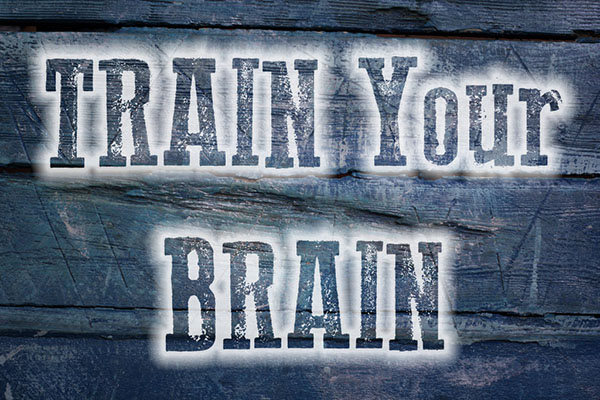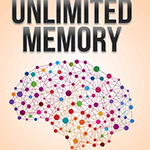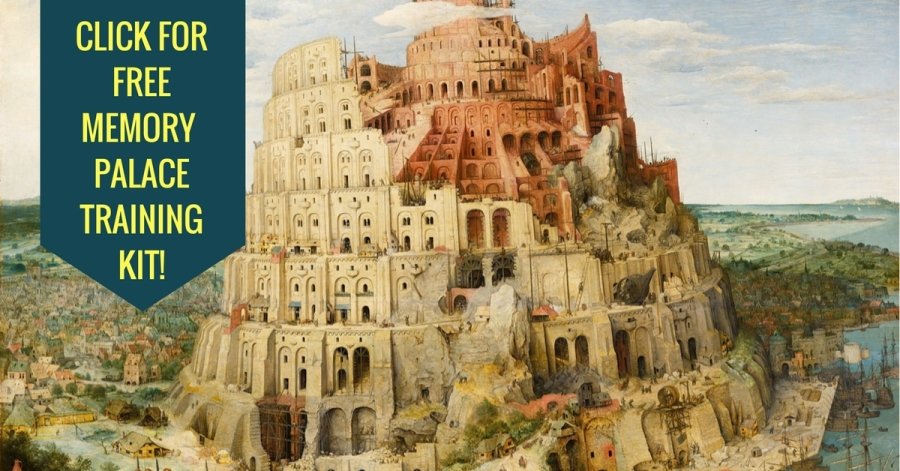Wed, 28 January 2015
In this episode of the Magnetic Memory Method Podcast, Grand Master of Memory Mark Channon talks about memory improvement from his perspective as an actor, personal trainer and game show host creator. As the author of How to Remember Anything, Channon presents us with stimulating ideas and actionable techniques you can get started using right away. This interview truly demonstrates just how profound his Total Memory Blueprint will be for you. And in this interview, you’ll learn: * How to build your memory skill set, even if you’re a busy person. * How to memorize the streets of London using a Memory Palace, a bit of 21st Century technology and mnemonic chaining. * How to create powerful reference stories that you can refer to months and years later to recall information. * Exactly how it feels to compete in the World Memory Championships. * How to deal with the occasional “effort” involved in the fun and games of using memory techniques by discovering your purpose. * How to develop concentration, even if your body is busy as a beaver. * How to let go of your inhibitions and remember more without even using any memory techniques whatsoever. * The secrets of being present and active listening and the three levels of communication to focus on. * How to memorize lines for an addition for a Stephen Spielberg film in a foreign language – even if you’ve never learned a word of that language before! * The best mindset to develop for memorizing long texts verbatim. * How to create visual (and yet invisible) cue cards. Use these during a presentation to recall a memorized speech without taking yourself out of the moment. This is great for people who “skip a beat” while searching through Memory Palaces. * What you can learn about mnemonics from Iron Man in the Avengers. * How to use relaxation to create focus and energy without putting yourself to sleep. * How to harness the power of “tiny habits” to be more present, remember more information and deal with information overload. * How to use memory techniques to get tips if you work at a bar or restaurant and one crazy party trick that will amaze your friends – and make them wonder if they can trust you! * The importance of incorporating the fun of play into your memory improvement efforts. * Why you should focus on memorizing “anything” rather than “everything.” * … and much, much more. Amazing Clip From the Pilot Of Mark Channon’s Memory Masters Mini-MMM Review Of Mark Channon’s How To Remember Anything As you know, books on memory skills are a dime a dozen. And few are memorable. But what makes Mark Channon’s treatise and training on the art of memory so unique is its blend of unique ideas and Channon’s emphasis on sharing the sources of his learning and inspiration. And you’ll want to be following up on many of those sources. Ranging from training for actors to ideas drawn from psychologists, Channon not only helps you take control of your memory. You learn to take control of many other aspects of your life too. How to Remember Anything highlights the paradox of memory. It is both absolutely central and at the same time, peripheral to much that we do with it. Channon talks about the power of forgetting – or at least allowing ourselves to align so completely with the present that the ego steps out of the way. And when that happens, you can let memory fulfil its natural role of providing exactly what we need at exactly the right time. Channon compliments the book with brain science, but not to the point of overwhelm. If you’re interested in how and why the brain works, this book presents a snackable primer and all the resources you could ask for if you want to explore further. Each chapter of the book is well-structured and the exercises pack a punch. Many have value apart from raw memorization as well. You can use them to learn more, develop creativity, think critically at a higher level and elevate your communication style. In sum, How to Remember Anything gives particular understandings of the classic memory techniques that will widen your perspective of how they can be used. And there is plenty more for those interested in memory improvement that you won’t encounter in other books on mnemonics, so be sure to check this one out. Resources Mentioned In The Podcast And More! Mark Channon’s free resources on his Memory School website Mark Channon’s World Memory Championship stats How to Remember Anything on Amazon The Memory Workbook on Amazon BJ Fogg’s Tiny Habits The post Memory Improvement Fun And Games: Mark Channon Talks About How To Remember Anything appeared first on Magnetic Memory Method - How to Memorize With A Memory Palace.
Direct download: Memory_Improvement_Fun_And_Games__Mark_Channon_Talks_About_How_To_Remember_Anything.mp3
Category:Podcast -- posted at: 1:34pm EDT |
Wed, 21 January 2015
C’mon, admit it. You think that learning how to increase memory skill and ability is going to be a drag. You’ve seen all those pictures of memory champions with their sound cancelling headphones and nothing could seem more boring. But the truth is that you can improve memory ability simply by using something you already do almost every week, if not every day. That’s right: Merely by watching a movie and thinking about it in a few deliberate ways afterwards, you can exercise and improve memory by an impressive margin. Here’s how: Use The Power Of IntentionBut intend to do what, exactly? Intend to pay attention for the sake of your memory. Harry Lorayne makes the point again and again in his books that memory ability begins and ends with our attention. After all, you simply cannot remember anything to which you haven’t consciously attended. Pay attention to the next movie you watch with the intent to remember more and you’ll already give yourself a cutting edge memory increase beyond belief. Reconstruct The StoryYou probably haven’t done this since you were a kid. You watch a movie and then immediately get on the phone and retell the entire story to a friend. At least, I remember doing this as a kid and I loved hearing my friends recount what they had seen. Back then, after all, if you missed a movie at the theatre, it could be six months to a year before it appeared on videocassette. And even then, there was no guarantee that a video store in your town would carry it for rental. “A Story Told Is A Story Shared”The exercise here is to watch a movie and retell the story to someone. If you cannot find someone to relate the narrative to, tell it to a pet. Speak it into a recording device. Or even just write it down. Who knows? You could wind up becoming a great film reviewer and critic and memorizing what happens in movies for a living. For bonus points, do both: verbally recount the film and write your description down. This will exercise more parts of your memory and improve recall in a deeper way, especially of you make this a regular affair. And keep in mind, this description doesn’t have to be super-lengthy. When I recall the plot points of a movie in writing, I can usually squeeze it all on to a mid-sized index card, the kind that is about half the size of a sheet of paper. If you’re interested in more about memorizing plot points, you can check out this episode of the Magnetic Memory Method Podcast on memorizing plot points. For extra extra bonus points, listen to someone else tell back the story of a movie they’ve seen. There will probably be some back and forth as they revisit the story from memory, but just let them talk it through. Commit to memorizing at least three major pieces of information.
Hold On To The Names Of CharactersMy girlfriend at the time and I had been watching Deadwood. If you like Westerns, this is a great series. Anyhow, in season two a new character showed up and we both immediately recognized the actress. “What was her name in Breaking Bad?” my girlfriend asked. “Skyler,” I said immediately, “Skyler White.” How did I remember this character’s name so easily and my girlfriend did not – even though we had watched the entire series together, episode by episode? I deliberately paid attention to character names, that’s how. Now, to be fair to this former girlfriend, she never liked Skyler much and doesn’t have the same ten year plus track record that I do as a Film Studies professor. Plus, she didn’t work on memory development using movies the way I do. Or learn how to enhance vocabulary with a Breaking Bad Memory Palace like you see in this video: In this case, it’s not so much that she couldn’t remember Skyler’s name, but that she found it too unimportant to hold in memory. And perhaps her active dislike for the character (who is admittedly dislikable), actively deleted the information from her mind. It would also be hard to say that I would have remembered her first name of I hadn’t actively paid attention to it. Her husband, Walter White, is easy. It’s alliterative, for one thing, which is a simple aid to memory. Plus, “Walter” brings so many character-associated traits to mind: he’s old-fashioned, conservative, cantankerous and it’s easy to see him becoming an old man sitting in a rocking chair on the porch of The Walton’s. Finally, “White” makes you think of the white hat of the good cowboy and innocence is a constant theme throughout the series as Walter White transforms episode by episode into the monster Walter Black. Anyhow, even though Skyler’s name is not as easy to place thematically and has no mnemonic alliteration like the W. W. in Walter White, it was still easy to instantly memorize. How? By associating it with other information worth memorizing to build fast familiarity with the story and increase memory with this simple exercise. For example, I noticed that the story takes place in Albuquerque, New Mexico. There’s almost always a blue sky in this part of the US – at least as seen on the show. Thus, a simple memory association locked the name instantly into place. I also happened to have known a First Nations person named “Calm Sky” when I first started my higher education at Okanagan University College. Bringing this simple fact together strengthened the association even further. Doing Your Homework Has Never Been So Much FunYour homework is to pay attention to character names in the movies you watch and create associations. Are the names obviously constructed to be memorable and thematically rich like “Walter White?” Or are they more abstract like Skyler? You can also create a simple rhyme. For example, Skyler rhymes with Tyler, so you could see her kissing Stephen Tyler from Aerosmith and say it in your mind as you picture it: “Skyler kisses Tyler.” Maybe you’ll even hear an Aerosmith love song as you do this, strengthening the memory by adding color and emotion to the extended context. Believe me, you can think about these questions, answer them and do rhyming exercises while watching a movie without skipping a beat of the story. And it’s great mental exercise that will show you how to increase memory while you’re doing it. It’s also a wicked amount of creative fun. Pay Attention To Where The Characters Live And Where They GoThe mind has an incredible ability to map its surroundings, especially when buildings are involved. Although buildings in movies and series are less distinct than the ones you experience in real life, you can still use them to increase memory power. For example, think of a favorite show or movie. The Lord of the Rings as a whole is fairly indistinct to hold in the mind, but you can probably reconstruct a fairly accurate image of what Bilbo Baggins house on the Shire looks like on the inside – assuming you’ve seen the Peter Jackson film. Same thing for the home of Walter and Skyler White in the Breaking Bad house. You might not remember the exact layout, but in effect, there is the master bedroom, the baby’s bedroom, Walt Jr.’s bedroom, the heating closet where the cash is later hidden under the floor, the washroom, the kitchen, the dining area, living room, patio, pool, fence and driveway. These are all clearly defined areas throughout the series. And if you think about it, you can probably reconstruct the different places that Jesse lived, Hank’s house, Mr. Fring’s And if you can’t bring all of these places to mind at even a superficial level based on the stories I’ve mentioned, then it’s easy to get started on using them to improve memory. Do These Steps To Exercise Your Spatial Memory* Watch a movie or series episode And you can take all of this one step further by using the materials from this memory exercise and turning them into a Memory Palace for use with the Magnetic Memory Method Masterclass. Also, if you go to movie theatre, you can use that location as a Memory Palace too. But that’s a topic for another time, so please do make sure that you’re subscribed to the Magnetic Memory Method for more training and ideas like these. But Wait! There’s More …In the meantime, there’s so much more you can do to improve memory by watching movies and series. For example, you can try to hold the clothing of a character in mind as you move them through the location you’ve mentally reconstructed. It’s almost like playing with Barbie dolls or GI Joe figurines to develop hand-eye coordination. Except in this case, you’re doing it entirely in your mind. Throw drawing into the mix, and about 300 physical muscles will join the game, exercising your brain, your memory and small but critical parts of your body all at the same time. And although there will be more work involved, you can extend all of the techniques you’ve learned to novels. You just need to fill in more of your own details, which as Stephen King talks about in On Writing, you’re probably going to do that anyway instead of following what the author says by the letter. And if you are going to use your own visual imagination as you please, why not do so deliberately and experience memory improvement as a result? It all comes down to the same old truth. You make improvements by taking action. So get out there and watch some movies! Further Resources Complete lists of characters from Breaking Bad and Deadwood. Use them in your memory practice. 8 Movies About Memory Manipulation And How They Inspired Real Neuroscience The post How To Increase Memory By Watching Movies and TV Series appeared first on Magnetic Memory Method - How to Memorize With A Memory Palace.
Direct download: How_To_Increase_Memory_By_Watching_Movies_and_TV_Series.mp3
Category:Podcast -- posted at: 6:59pm EDT |
Thu, 15 January 2015
There’s a feeling of powerlessness that comes with failing to recall information, isn’t there? And the more important the information – be it a name, a mathematical formula or a word – the higher that feeling of having no power over your memory becomes. But you really don’t have to suffer from this powerlessness. You can learn how to increase memory power. And the good news is that a meaningful transformation can occur almost overnight using these three simple steps.
1. Determine what “memory power” means to you.
Go ahead and get out a piece of paper or something to write on. Then, without thinking about it too much, write down everything that comes to mind related to your personal concept of memory power. If you like, you can also create a mind map. Mind maps are great because they free you from many aspects of linear thinking and let you see different connections that normally go unnoticed. Make sure that you spend 5-10 minutes on this exercise before taking a break. Then come back to it, assess what you’ve written and add any more details that come to mind. In particular, search your writing and/or mind mapping for three kinds of information that can be placed into different categories. These categories are “fears,” “opportunities” and “strengths.” (I’ve adapted terms from a coach named Dan Sullivan for use in your world of memory improvement, but if you’re an entrepreneur, check out his teaching sometime soon.) Then, on another sheet of paper, put a headline on top that says something like “how to increase memory power.” Beneath that, create three columns, one for each category. For example, when I completed the prose version of this exercise, I wrote: Memory power means the ability to recall anything I’ve studied at any time and under any condition. Relaxation is always part of the process of memory power. It also means learning and memorizing information that will actually make a difference to the quality of my daily life. True memory power exists when I’m able to share the processes and results of how to increase memory power with others. The mind map version (because I think it’s important to do both) looks like this:
* Memorize Facts Next, on the three column sheet, map everything onto the three categories. Scroll to the Further Resources section of this post to download a worksheet if you prefer that to free writing on a blank page. Fears Not being able to concentrate Strengths Creativity Opportunities 45 mins for memorzing vocabulary
This Memory Power Exercise Eliminates All Fear
In sum, this exercise helps not only define what memory power means to you and how to improve it. The exercise also identified your fears. With awareness of these, you can eliminate them one at a time from your life before proceeding to the next exercise. Some people may think this first step towards memory improvement is too involved. However, this should take no more than 5 minutes to complete. You might want to revisit it every so often to see where you stand, however. In other words, your personal definition of memory power is not a “set it and forget it” thing. It’s living, breathing and subject to change as your memory power evolves into something much better.
2. Set a specific goal and study memory techniques.
Every body has heard of SMART goals. To quote from the Wikipedia entry, SMART goals are: Specific – target a specific area for improvement. Measurable – quantify or at least suggest an indicator of progress. Assignable – specify who will do it. Realistic – state what results can realistically be achieved, given available resources. Time-related – specify when the result(s) can be achieved. On the final note, it is often suggested that you add a deadline. However, the extent to which this matters (or any of the SMART goal conditions matter) is entirely up to you. In truth, even just having a goal in mind is better than nothing. But the more you can specify the conditions of the goal, the better. That’s why it’s important to include research as part of any goal. Although this means adding an additional step to your goals, it also means you’ll be able to proceed towards your goal on an informed basis. What does research mean when it comes to learning how to increase memory power? As we’ve seen in the previous exercise, it means starting by researching yourself and your memory improvement needs. But the next step is to do some research into memory improvement techniques themselves.
Brace yourself, because there are a lot of them – or at least, there are a solid core of different memory techniques that are taught in different ways by different people. This can lead to the impression that there are literally thousands. But as in card magic where there appears to be a zillion tricks, the reality is that magicians are presenting variations on a small set of themes. To help you navigate the vast world of memory training, I’ve created the Memory Training Consumer Awareness Guide so that you can make an informed decision when choosing a memory training that’s right for you. Please take some time to go through it in either its Mp3 or PDF format and feel free to let me know if you have any questions at any time. After you’ve researched memory techniques and started using them, it’s important to keep practicing. It’s kind of like the way a musician approaches an instrument or an actor approaches the craft. No matter how good you get, you keep playing and performing. It’s not just that the skills need to be maintained – it’s that they need to become a way of life. And just as actors are called actors and musicians are called musicians, there is a name for people who take up memory techniques as a lifelong practice. They’re called mnemonists, though you can also just use the term Memorizer. No matter what you call them, these are some the most Magnetic people on the planet because they’ve taken the natural abilities of their minds – normal abilities that everyone has – and sharpened them. How? Certainly by spending time in self-analysis, doing research and setting goals. So if you’re ready to join their ranks, here’s another exercise.
Determine Exactly What You Want To Memorize
List these down on the a piece of paper. For me, the most important things are foreign language vocabulary, grammar principles, names and faces, facts about art and poetry (which includes the ability to memorize quotes, jokes and even entire speeches). For you, it might be math, programming languages and passwords. There are all kinds of needs, and better you can identify what your memory requirements are, the better the memory training you can seek. My advice is that you concentrate on the memory needs that are going to help you the most right now. If memorizing poetry and all the things that go along with it (quotes, jokes, etc.) have no value to you, then save that for later. Focus on what will get you through school as an A+ student, get you a better job or whatever will bring you immediate pleasure first. Know what motivates you and then look for the memory training that will help you most directly. This will quickly boost your existing motivation even higher because you’ll suddenly see and feel just how quickly you can achieve your goals through memory improvement. Obviously, there are a lot of memory trainings to recommend, but I think you’re best off doing some research of your own. And in addition to my consumer awareness guide, you can readily visit the Magnetic Memory Method resources section too. But because research is such an important part of self-development, do make sure to do some – you’ll learn what research is best by simply doing it, but in brief, here are some tricks of the trade I’ve learned over the years as a student, graduate student and research professor.
Get. Off. The. Internet.
Look, the Internet is awesome. No one is denying that. However, so little of all the print material has yet to appear online. There are books, magazines and articles, audio programs and even old videocassettes that still work that are not and probably never will be online. If you want the fullest possible range of knowledge, go to libraries, used bookstores and for older trainings, go to the Internet, but look at Ebay for old memory training materials. You’ll probably be amazed by what’s kicking around. Here’s another way to get off the Internet with a simple visualization and memory exercise:
When On, Use The Internet Intelligently
Most people run to Google and pop in a bunch of words. However, there are specific search terms you can add in order to radically narrow and improve your searching. Try, for example: Intext More search parameters exist, but these are the ones I typically use. * If you have access to a university library, read journal articles, dissertations and even entire books exclusive to these services. Some public libraries can grant you access to these as well, so ask a librarian. People who don’t physically go to libraries and many people who do don’t realize what a powerful resource a trained librarian can be. They literally search and organize material to be searched and found for a living. * Read outside of the memory improvement genre. Not only do memory techniques appear all over the place in different kinds of books and personal development trainings, but such resources contain all kinds of techniques that you can build onto your approach to memory. This is one of the many aspects that makes the Magnetic Memory Method unique. Relaxation, mindset and scientifically verified methods for generating greater happiness have been included. Of all the books I recommend on a regular basis, 59 Seconds by Richard Wiseman is probably one of the best. The simple technique of writing down 10 good things that happened to you every day is worth more than a billion dollars, and I’ll probably repeat that simple lesson a billion times if I live long enough to do it. It’s been that valuable to me and I know it will be that valuable for you too. And it’s ideas that you’ll come across when you read outside of the memory improvement genre. But don’t just rest on the ideas – act on them. You’ll never experience flight by reading about airplanes. At some point you’ve actually for to get on one and actually get into the sky. This is totally an aside, but in writing this, I’m reminded of the poet Ezra Pound. When investigators brought him home from Italy to America to stand trial for treason, he strolled the aisle and whistled as the plane loped the sky over the ocean. This was used as evidence of his mental instability at his trial, but even though he would spend the next 12 years locked up in a mental hospital, the truth is that he was just happy. It was the first time he had ever flown. As with the other exercises, all of this should be fun. Even just 10-15 minutes a week can expand your expertise of the world of memory in rapid order while making you a better researcher overall. Making research part of your memory improvement goals also serves as several memory exercises at once because you’re expanding your knowledge of the field. Working memory processes information and you’re feeding yourself details about ideas and books that you can recall later from long term memory. If you want, you can even use a Memory Palace to memorize the titles of books and articles you’ve read for revisiting later or for your overall knowledge of memory techniques and memory improvement strategies. 3. Create A Personal Memory Power Improvement Program
Now it’s time to implement what you’ve been learning. But implementation without a plan is a dangerous business. Why? Because if you’re working and not getting results, you wind up frustrated. Frustration leads to inactivity. Inactivity leads to abandoning goals. Abandoned goals lead to more frustration, and before you know it, you’re far from where you could be. Worse, you might never wind up coming back. And that would be a tragedy because success with memory techniques is always just around the corner. (Even if you’re already accomplished, the next level also awaits if you regularly implement, experiment and make modifications according to your carefully defined goals.) As is clear to those who follow the Magnetic Memory Method, the Memory Palace is the be-all and end-all to your success with memory improvement. This doesn’t mean that it’s the only way, and this recent correspondence with a reader of How to Learn and Memorize Russian Vocabulary shows that. However, for most people, a well-designed Memory Palace is easy to create and even easier to use. Everything you need is available in the free Memory Palace Mastery video series (click the registration link at the top of the page). It’s never to late to develop this simple skill. Although the explanation is detailed and will take a little time to learn, the reason I go into such depth is because I want to ensure your success. I’ve seen it time and time again that most people experience the highest levels of success when they get the Memory Palace part of the memory improvement equation right the first time. Please don’t miss this special memory improvement opportunity available to you now for free. Once you’ve got a Memory Palace prepared, it’s actually time to build another one even before you start using the first one. I know this probably sounds crazy (and in fact some people have told me that it is crazy), but the reality is that you need more than one Memory Palace and multiple Memory Palace construction is in and of itself an extraordinary memory development exercise. If you’re building Memory Palaces in a fully informed manner, each one should take approximately 5-10 minutes each. Later, with a couple of Memory Palaces under your belt using the Magnetic Memory Method free video training and worksheets you get when you subscribe, pick something that fits one of your goals as described above. There’s no point practicing memory techniques by memorizing a shopping list (the typical, boring exercise that most memory trainings start with) – unless you absolutely love shopping and this ability will improve your life immediately and/or bring you enormous joy. Otherwise, pick something that interests you fiercely and will improve your life. Many people who are learning a language and have struggled a bit with the process will get an immediate boost from doing this. If you’re a businessperson, you might opt for learning to use Memory Palaces for names and faces or numbers first and practicing these will be of the greatest benefit. If you’re a student, you might want to practice with a list of important facts that are bound to show up on a quiz or a test. The more aligned your practice is with your goals and ambitions, the more you’ll be able to lock them onto your opportunities and eliminate your fears. It’s really that simple and really that fun. And the impact will move forward through time as you grow in life as an individual, as a learner and as a Memorizer (or mnemonist) if you prefer. In sum, increasing your memory power is easy and fun to do. That doesn’t mean it’s not without effort, however, though as I always like to say, even chocolate and sex require effort – and they’re both fantastic, as are advanced memory abilities. Don’t get scared off by the word “advanced.” It really means “forward,” as in moving forward. And as long as you’re moving forward, you truly are advanced. And that forward movement is the most important thing in the world. Without a doubt. Further Resources Download this worksheet so you can fill out your own Memory Power fears, strengths and opportunities sheet and start making massive improvements to your memory Pure Genius by Dan Sullivan Previous episode of the Magnetic Memory Podcast: Want Unlimited Memory? Get This Book! Magnetic Memory Method article on Tony Buzan, a master of memory and deep thinker of how to make world class mind maps Fabulous list post on Year Planning Mind Maps from mindmappingsoftwareblog.com All of Richard Wiseman’s books on his blog. Hint: The link to Night School points to Amazon.co.uk. If you replace the “co.uk” with “com” without changing any other part of the address, you’ll find this book on the U.S. store. This trick works for other Amazon stores around the world too. It’s magic. The post How To Increase Memory Power With These 3 Fun Exercises appeared first on Magnetic Memory Method - How to Memorize With A Memory Palace.
Direct download: How_To_Increase_Memory_Power_With_These_3_Fun_Exercises_Magnetic_Memory_Method.mp3
Category:Podcast -- posted at: 4:27pm EDT |
Thu, 8 January 2015
Program Notes Kevin Horsley’s recent book, Unlimited Memory is worth your time. If you’re a student and user of memory techniques, this written version of the podcast will tell you why. There Are No New Memory Techniques Under the Sun … Or Are There? As most people interested in the art of memory techniques know, there’s nothing new under the sun. The memory improvement methods were invented thousands of years ago and refinements have been slim. But that doesn’t mean that innovations haven’t occurred. Not only that, but memory techniques improve every time someone takes up using them and feels the power of empowered recall. And that’s why no matter where you are in your journey as a memorizer, Horsley’s book merits your full attention. Why? Because if you’ve never learned memory techniques before, his straightforward and energetic manner will serve as a great introduction to memory improvement. And if you’re already an old hat with using mnemonics but have lapsed, Horsley will inspire you to get back in the saddle. New Ways To Think About Old Techniques Plus, you’ll find new ways to think about the techniques. Fresh perspectives can be more valuable than the techniques themselves in some cases if they inspire you to keep going. And the book is filled with great quotes that place memory techniques in interesting new contexts. In fact, every single one is worth committing to memory. Horsley’s quotable too. “Conflict,” he points out, “is the opposite of concentration,” and much of the book talks about removing everything that gets in the way of your progress so that you can focus on. Horsley’s point about conflict in this context should be confused with having conflict in your associative-imagery, however. Although I’m not interested in being critical of the book, it is slim on how to include rigorous to help you a) memorize information and … b) recall it. Mnemonic Examples On Almost Every Page For those who feel the need for examples, you couldn’t find more to choose from. For each principle, you get tonnes of written illustration to imagine along with. From a pedagogical standpoint, this may be overkill and the book lacks some guidance on how to be creative and “see” those images in your mind. In terms of visuals, there are a couple throughout the book, with the illustrations limited mostly to explaining number memorization using the Major Method. I personally like the limited number of illustrations because it is important to recreate what you see in your mind, not what others see. This is why the overkill on text-based images can help you so long as you work at recreating them in your mind. Use These Powerful Visualization Exercises If you would like some fast and easy exercises for developing your visual imagination, try looking at paintings and then recreating them in your mind. You can also verbally express them on paper in a short paragraph and use what you’ve written as the basis for recreating the imagery in your imagination. And please realize that you don’t need to literally “see” the images in your mind in order to increase your memory power when using this memory technique. It doesn’t have to be high-definition television. Verbal expression in your mind (even without writing the words down) can be just as powerful. But please do work on visualizing. And to develop the skill further, think about what being visual in your mind actually means to you. If you struggle in this area, you might be pleasantly surprised at how simply thinking through this issue and defining what imaginative visuality means to you can give you the basis for truly creating improvement. How To Take Your Brain To The Gym Think of this defining process as laser targeting what’s really going on. It’s kind of like the difference between going to the gym to reduce general flabbiness and getting no results and going to the gym with a trainer who knows exactly which muscles to develop so that you burn the most calories. And of course you need to eat the right foods to support this process, which in the case of developing your visual imagination means looking at art on a regular basis and mentally recreating it. Horsely uses the gym metaphor himself when he talks about memory training. He points out that no one is born ripped out with big muscles. They must be trained. The same goes for memory power. Your mind is a muscle and you can develop it. Even just reading about memory techniques can help, but nothing beats getting into the gym and pumping the iron of actually memorizing information that can help improve your life. The Most Interesting Practice Items You’ll Ever Find In A Memory Improvement Book And that’s a cool feature of Unlimited Memory. Unlike so many memory training books that guide you through memorizing lists of objects and food items for your next grocery item, Horsely is a bit more creative in his suggested practice items. You’ll have to check him out to see what I mean. You’ll be pleasantly surprised and Unlimited Memory is one of the strongest books you’ll find in the department of giving you great practice material that serves more than one purpose. If you’re looking for in-depth training on Memory Palace construction, you may be a little disappointed, however. The Method Loci is covered, but the instruction lacks the nitty-gritty matters of making sure the path is linear and not crossing your own path. Following these principles will limit confusing yourself and spending unnecessary mental energy while maximizing your attention on decoding the associative-imagery you have no problems finding. Criticisms completed, let’s return to the good stuff – but please don’t let my nitpicking dissuade you from reading Horsely’s Unlimited Memory. It is a powerful resource and I intend these comments to supplement the book rather than poke a stick at it. You can, in truth, never read enough books about memory improvement even if not all of them are created equal. Learn How To Eliminate All Your Negative Memory Beliefs And Unlimited Memory excels in teaching the cost of negative beliefs and replacing them with constructive ideas that propel you into positivity. For example, Horsley encourages you to keep your mind open while showing you all of the little thoughts that are constantly working to shut your open mindedness down. This will help keep you on the path towards experimenting with memory techniques and getting results. Unlimited Memory Is Also An Amazing Research Memory Resource Horsely is also tremendously generous in sharing the books he’s read and the fruits of his research. Not just what he’s read about memory, but self-development books too. You’ll want to supplement your reading of these as well. And this such a powerful area that really makes the difference in a memory book. Without pointing you to other resources, so many books on memory development rob you of the chance to take the next steps in this field of specialization, which will always involve reading one more book. After all, the best books on memory are always yet to come. As Phil Chambers says in this podcast interview, the limits of memory improvement have yet to be reached. And as we push forward into new frontiers, new books documenting and teaching the processes will emerge. I hope Horsely will be there to write again. In sum, Horsely’s Unlimited Memory is a powerful introduction to memory techniques and you cannot go wrong because he points you to other reading and gives you much more interesting examples to start off with. And if you’re already on the path, you’ll find a good review and interesting perspectives. You simply cannot lose by reading Unlimited Memory. Further Reading & Listening Remembering the Presidents by Kevin Horsley Moonwalking with Einstein on Amazon The Art of Memory on Wikipedia
The post Want Unlimited Memory? Get This Book! appeared first on Magnetic Memory Method - How to Memorize With A Memory Palace. |
Sat, 3 January 2015
Photographic memory techniques, sometime confused with eidetic memory, are usually connected with a scam. Photographic memory is always scammy because …
Photographic Memory Does Not Exist!
Not only that, but it’s really not even something any sane person wants. Think about it: Why, unless you’re a painter, would you want to memorize every single detail of, say, a room or landscape? Even then, most serious artists would still want to make a quick study sketch, if not take a legitimate photograph. Thus, in most cases, the ability to clearly memorize only what you need always serve you much better than cramming it all in. That’s why spending some time clarifying exactly what you want to memorize is so important. For example, a lot of people ask me about memorizing an entire book, specifically textbooks. But I caution against spending time on this. So much so that I created an entire podcast episode about how to memorize a textbook the right way. In reality, you need only memorize the most critical pieces of information needed. The fear so many people have that makes them wish they had a photographic memory is this: They Don’t Know What Information Will Be CriticalThere’s a few solutions to this problem (also covered in the textbook memory training I linked for you). But the biggest step of all is this: Give up the phony notion photographic memory techniques exist. Even better, get my free memory improvement course and Memory Palace kit: After registering for this memory training material, understand this:
Your Memory Can Be Better Than Photographic. |
The Magnetic Memory Method Podcast

Categories
generalMemory Improvement Tools
Memory Method Tips
Brain Exercises for Memory Improvement
Memory Improvement Case Studies
Podcast
Guest Post
Memory Palace Tactics
Practical Memory Techniques
Uncategorized
Improve Memory Q&A
Archives
AprilMarch
February
January
December
November
October
September
August
July
June
May
April
March
February
January
December
November
October
September
August
July
June
May
April
March
February
January
December
November
October
September
August
July
June
May
April
March
February
January
December
November
October
September
August
July
June
May
April
March
February
January
December
November
October
September
August
June
May
April
March
February
January
December
November
October
September
August
July
June
May
April
March
February
January
December
November
October
September
August
July
June
May
April
March
February
January
December
November
October
September
August
July
June
May
April
March
February
January
December
November
October
September
August
July
June
May
April
March
February
January
December
November
October
September
August
July
June
May
April
March
February
January
December
November
September
| S | M | T | W | T | F | S |
|---|---|---|---|---|---|---|
| 1 | 2 | 3 | ||||
| 4 | 5 | 6 | 7 | 8 | 9 | 10 |
| 11 | 12 | 13 | 14 | 15 | 16 | 17 |
| 18 | 19 | 20 | 21 | 22 | 23 | 24 |
| 25 | 26 | 27 | 28 | 29 | 30 | 31 |
Syndication






 I’ve give you this handwritten image because that’s exactly how I suggest you write out your mind map. It takes just a few seconds. But in case you can’t read my handwriting or interpret my short form, here’s the list of what “memory power” means to me. It’s the ability to:
I’ve give you this handwritten image because that’s exactly how I suggest you write out your mind map. It takes just a few seconds. But in case you can’t read my handwriting or interpret my short form, here’s the list of what “memory power” means to me. It’s the ability to: Again, this isn’t rocket science. Just a simple sheet of paper will do. So you can make out what I’ve written, here’s the words in type (and in more normal English):
Again, this isn’t rocket science. Just a simple sheet of paper will do. So you can make out what I’ve written, here’s the words in type (and in more normal English):






